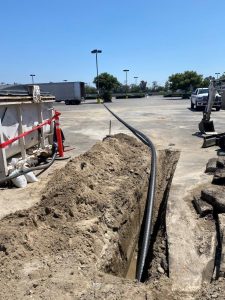Double-Ended Sometimes the Only Option
Ellingson-DTD crews recently completed a series of double-ended horizontal Air Sparge (AS and Soil Vapor Extraction (SVE) wells at an industrial facility in the central united states. The project highlights an important lesson for designing horizontal remediation wells: BE FLEXIBLE!
When planning remediation wells, the well installation configuration represents one of the bigger variables. Remediation engineers love the limited surface footprint and minimal drilling footage associated with single-ended or “blind” wells. However double-ended wells are generally easier to construct than blind configurations, especially within difficult geology.
Double-Ended Wells As Plan “B”
When possible, it’s advisable to have worked out a “plan B” when going into a blind well installation project. While the driller’s experience, the mud management program, tooling selection etc. certainly affects the success rate for single-ended wells, ground conditions tend to trump any of those variables. If the ground conditions aren’t conducive to a single-ended completion there is only so much you can do.

Pullback of HDPE Horizontal Well
The original design of this recently completed project involved a total of seven (7) horizontal wells (2xAS and 5xSVE). That design called for all the wells to be installed in a single ended configuration. The site was a relatively open area within the facility, which technically afforded enough room for double ended construction. It’s just that the owner of the property wanted to minimize the impact to recent landscaping and parking lot construction.
Unfortunately, geology has little consideration for our landscaping and parking lots. During drilling, the crew encountered heaving sands and cobbles ranging between golfball to baseball size. That was the natural formation! In areas around the new parking lot, they encountered highly compacted gravel road base and controlled density fill (CDF).
Those descriptors imply incredibly challenging conditions to just drill through, much less to maintain an open horizontal bore long enough to PUSH in HDPE well materials.
Despite the crew’s best efforts, single-ended completions just weren’t feasible. Fortunately, the team had prepared for this possibility and discussed the alternative approach of converting the wells to a double-ended configuration. The team brought several different sets of tooling for either approach, they had ordered extra well materials to adapt to any configuration, and everyone maintained excellent lines of communication to keep the property owner informed.
Tags: air sparge, blind wells, challenging geology, doulbe-ended, HDD, heaving sands, horizontal wells, limited access, remediation, single-ended, SVE